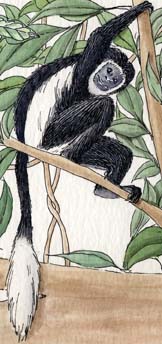

All colobus monkeys are found in central Africa.
The colobus lives most of its life in the trees (arboreal) of tropical rainforests and mountain forests.
Black and white colobus monkeys have long, black fur with white ruffs running down the sides of their backs to their tails. They have a long, bushy tail, with a white tip. Their tails make up half of their length, which can reach over 5-feet-long. They weigh about 30 pounds.
They live in small groups of about a dozen members of females and young, with only one male.
Colobus monkeys eat leaves, twigs, fruit, and flowers.
Predators are large cats, humans, and some birds of prey.
Females are pregnant for 5-6 months (gestation) and have 1 baby.
The colobus can live about 20 years in the wild. They are listed as Lower Risk - least concern.
Kingdom: Animalia
Phylum: Chordata
Subphylum: Vertebrata
Class: Mammalia
Order: Primates
Suborder: Haplorrhini
Family: Cercopithecidae
Subfamily: Colobinae
Genus: Colobus
Species: Colobus guereza
When you research information you must cite the reference. Citing for websites is different from citing from books, magazines and periodicals. The style of citing shown here is from the MLA Style Citations (Modern Language Association).
When citing a WEBSITE the general format is as follows.
Author Last Name, First Name(s). "Title: Subtitle of Part of Web Page, if appropriate." Title: Subtitle: Section of Page if appropriate. Sponsoring/Publishing Agency, If Given. Additional significant descriptive information. Date of Electronic Publication or other Date, such as Last Updated. Day Month Year of access < URL >.
Amsel, Sheri. "Monkey (Black and White Colobus)" Exploring Nature Educational Resource ©2005-2024. December 14, 2024
< http://exploringnature.org/db/view/348 >

